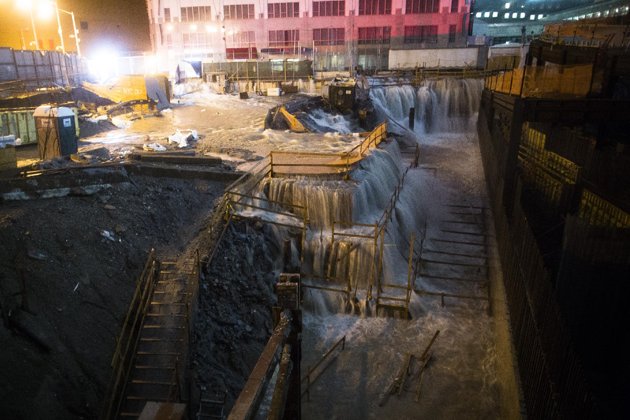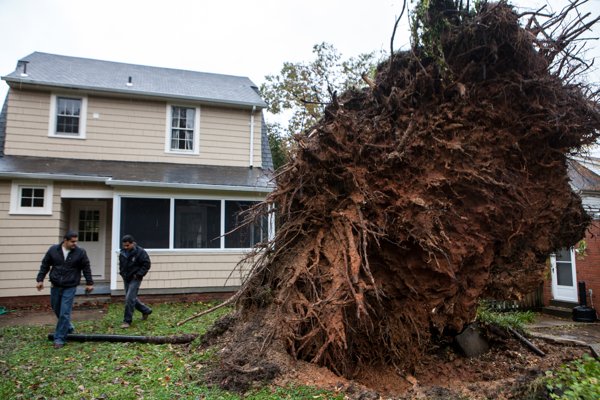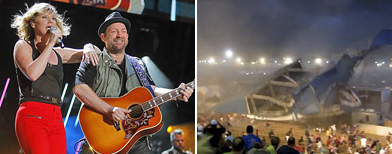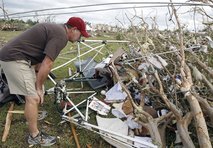
Associated Press/ John Minchillo – Sea water floods the Ground Zero construction site, Monday, Oct. 29, 2012, in New York. Sandy continued on its path Monday, as the storm forced the shutdown of mass transit, …more schools and financial markets, sending coastal residents fleeing, and threatening a dangerous mix of high winds and soaking rain. (AP Photo/ John Minchillo)
NEW YORK (AP) — Millions of people from Maine to the Carolinas awoke Tuesday without power, and an eerily quiet New York City was all but closed off by car, train and air as superstorm Sandy steamed inland, still delivering punishing wind and rain. The U.S. death toll climbed to 33, many of the victims killed by falling trees.
The full extent of the damage in New Jersey, where the storm roared ashore Monday night with hurricane force, was unclear. Police and fire officials, some with their own departments flooded, fanned out to rescue hundreds.
“We are in the midst of urban search and rescue. Our teams are moving as fast as they can,” Gov. Chris Christie said. “The devastation on the Jersey Shore is some of the worst we’ve ever seen. The cost of the storm is incalculable at this point.”
At least 7.4 million people across the East were without electricity. Airlines canceled more than 12,000 flights.
Lower Manhattan, which includes Wall Street, was among the hardest-hit areas after the storm sent a nearly 14-foot surge of seawater, a record, coursing over its seawalls and highways and into low-lying streets.
Water cascaded into the gaping, unfinished construction pit at the World Trade Center, and the New York Stock Exchange was closed for a second day, the first time that has happened because of weather in more than a century.
A huge fire destroyed as many as 100 houses in a flooded beachfront neighborhood in Queens on Tuesday, forcing firefighters to undertake daring rescues. Three people were injured.
A downtown hospital, New York University’s Tisch, evacuated 200 patients after its backup generator failed. About 20 babies from the neonatal intensive care unit were carried down staircases and on battery-powered respirators.
And a construction crane that collapsed in the high winds on Monday still dangled precariously 74 floors above the streets of midtown Manhattan. And on Staten Island, a tanker ship wound up beached on the shore.
With water standing in two major commuter tunnels and seven subway tunnels under the East River, and Mayor Michael Bloomberg said it was unclear when the nation’s largest transit system would be rolling again. It shut down Sunday night ahead of the storm.
Superstorm Sandy Wreaks Havoc

Men survey a large tree that fell during Hurricane Sandy on October 30, 2012 in Washington, DC. The storm has claimed at least 16 lives in the United States, and has caused massive flooding across much of the Atlantic seaboard. US President Barack Obama has declared the situation a ‘major disaster’ for large areas of the US East Coast including New York City, with wide spread power outages and significant flooding in parts of the city. (Photo by Brendan Hoffman/Getty Images
Joseph Lhota, chairman of the regional Metropolitan Transportation Authority, said the damage was the worst in the 108-year history of the New York subway.
The saltwater surge inundated subway signals, switches and electrified third rails and covered tracks with sludge. Workers began pumping the water out and will ultimately have to walk all of the hundreds of miles of track to inspect it.
Millions of more fortunate New Yorkers surveyed damage as dawn broke, their city brought to an extraordinary standstill.
“Oh, Jesus. Oh, no,” Faye Schwartz said she looked over damage in neighborhood in Brooklyn, where cars were scattered like leaves.
Reggie Thomas, a maintenance supervisor at a prison near the overflowing Hudson River, emerged from an overnight shift there, a toothbrush in his front pocket, to find his Honda with its windows down and a foot of water inside. The windows automatically go down when the car is submerged to free drivers.
“It’s totaled,” Thomas said with a shrug. “You would have needed a boat last night.”
Besides the subway and the stock exchange, most major tunnels and bridges in New York were closed, as were schools, Broadway theaters and the metropolitan area’s three main airports, LaGuardia, Kennedy and Newark.
“This will be one for the record books,” said John Miksad, senior vice president for electric operations at Consolidated Edison, which had more than 670,000 customers without power in and around New York City.
The death toll climbed rapidly, and included 17 victims in New York State — 10 of them in New York City — along with four dead in Pennsylvania and three in New Jersey. Sandy also killed 69 people in the Caribbean before making its way up the Eastern Seaboard.
In New Jersey, a huge swell of water swept over the small town of Moonachie, near the Hackensack River, and authorities struggled to rescue about 800 people, some of them living in a trailer park.
And in neighboring Little Ferry, water suddenly started gushing out of storm drains overnight, submerging a road under 4 feet of water and swamping houses.
Police and fire officials used boats and trucks to reach the stranded.
“I looked out and the next thing you know, the water just came up through the grates. It came up so quickly you couldn’t do anything about it. If you wanted to move your car to higher ground you didn’t have enough time,” said Little Ferry resident Leo Quigley, who with his wife was taken to higher ground by boat.
Jersey City was closed to cars because traffic lights were out, and Hoboken, just over the Hudson River from Manhattan, dealt with major flooding. In Atlantic City, most of the world-famous boardwalk was intact, but pieces washed away Monday night.
Remnants of the hurricane were forecast to head across Pennsylvania before taking another sharp turn into western New York by Wednesday morning. Although weakening as it goes, the storm will continue to bring heavy rain and flooding, said Daniel Brown of the National Hurricane Center in Miami.
As Hurricane Sandy closed in on the Northeast, it converged with a cold-weather system that turned it into a monstrous hybrid of rain, high wind — and even snow in West Virginia and other mountainous areas inland.
In a measure of how big the storm was, high winds spinning off the edge of Sandy clobbered the Cleveland area early Tuesday, uprooting trees, cutting power to hundreds of thousands, closing schools and flooding major roads along Lake Erie.
Hundreds of miles from the storm’s center, gusts topping 60 mph prompted officials to close the port of Portland, Maine, and scared away several cruise ships.
Just before it made landfall at 8 p.m. near Atlantic City, N.J., forecasters stripped Sandy of hurricane status, but the distinction was purely technical, based on its shape and internal temperature.
While the hurricane’s 80 mph winds registered as only a Category 1 on a scale of five, it packed the lowest barometric pressure on record in the Northeast, giving it terrific energy to push water inland.
President Barack Obama declared a major disaster in the city and Long Island. The storm brought the presidential campaign to a halt with a week to go before Election Day.
In New York, the construction crane atop a 1,000-foot, $1.5 billion luxury high-rise in midtown Manhattan dangled for a second day while authorities tried to figure out how to secure it. Thousands were ordered to leave nearby buildings as a precaution, including 900 guests at the ultramodern Le Parker Meridien hotel.
Alice Goldberg, 15, a tourist from Paris, was watching television in the hotel — whose slogan is “Uptown, Not Uptight” — when a voice came over the loudspeaker and told everyone to leave.
“They said to take only what we needed, and leave the rest, because we’ll come back in two or three days,” she said as she and hundreds of others gathered in the luggage-strewn marble lobby. “I hope so.”
An explosion Monday night at a substation for Consolidated Edison, the main utility service New York City, knocked out power to about 310,000 customers in Manhattan.
“It sounded like the Fourth of July,” Stephen Weisbrot said from his 10th-floor apartment.
In Baltimore, fire officials said four unoccupied rowhouses collapsed in the storm, sending debris into the street but causing no injuries. A blizzard in western Maryland caused a pileup of tractor-trailers that blocked part of Interstate 68 on slippery Big Savage Mountain.
“It’s like a long-tailed cat in a room full of rocking chairs up here,” said Bill Wiltson, a Maryland State Police dispatcher.
___
Hays reported from New York and Breed reported from Raleigh, N.C.; AP Science Writer Seth Borenstein contributed to this report from Washington. Associated Press writers David Dishneau in Delaware City, Del., Katie Zezima in Atlantic City, Emery P. Dalesio in Elizabeth City, N.C., and Erika Niedowski in Cranston, R.I., also contributed.
Momma’s Source: yahoo news
Share This




